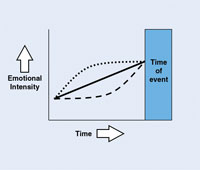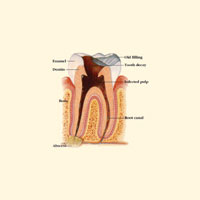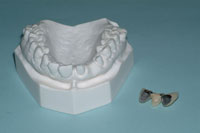The goal of appearance-related dental rehabilitation is the re-establishment of a healthy, maintainable, aesthetic,functional interface from an otherwise damaged dentition. To this end, a multi-dental disciplinary approach is necessary to fulfill cosmetic and functional requirements of the periodontal, orthodontic, and maxillofacial plastic disciplines for long-term success.This comprehensive approach ensures that the constituent components of the dentition have properly positioned and aligned the teeth prior to appearance-related prosthetic therapy. The inclusion, rather than the non-utilization, of orthodontic tooth movement as a component of the armamentarium for prosthetic rehabilitative therapy is key to obtaining the desired result of a beautiful smile that the patient can maintain over time. This can be achieved by the cosmetic dentist in his or her office through the process of orthodontist-direct limited tooth movement described as adjunctive orchestrated orthodontic therapy (AOOT).
AOOT and the Rehabilitative Process
The reassembly of a natural-looking dentition, ie, the healthy, maintainable, aesthetic, functional interface, is the altruistic objective of any appearance-related dental rehabilitation. From a damaged dentition, the rehabilitative process strives to establish a harmonious association of the prosthetic reconstruction with the existing facial and orofacial features (Figure 1). Adult orthodontic therapy has classically focused on the correction of dental malocclusions, severe tooth malposition, closure of diastemas, and isolated tooth eruption or uprighting. Appearance-related restorative care and the functional needs of the teeth and periodontium inherent in the therapeutic management of the stomatognathic system, in many instances, requires the repositioning of teeth in the anterior segment of the mouth. In some cases, minor therapeutic movement of the posterior teeth is also needed. More specifically, periodontal disease, plaque and calculus, subgingival margins, and excessive occlusal forces have been implicated as the etiologic agents and/or risk factors in the initiation,perpetuation,or extension of the disease process.

Fig. 1. A cosmetic result is the direct result of careful attention to details. (Dr. Daftacy, Strei-Oss Symposium, Newport Beach, 1997.) |
One risk factor that is most often overlooked, but continues to be a dentist’s nemesis, is the proximity and shape of the roots of the teeth in the aesthetic zone.6 In recent published reports, Chung et al demonstrated a direct correlation between misaligned teeth and the presence of increased levels of putative periodontal pathogens. The close proximity of these incisor roots creates a spatial environment that is deleterious to proximal alveolar bone, and detrimental to the long-term maintenance of the periodontal attachment in these affected areas. Furthermore, when the roots are too close in proximity, the papillary volume of tissue decreases, affecting macroscopically the form and dimension of the interdental papillary tissues and, microscopically, there is a notable decrease in the amount of connective tissue making up the dentogingival complexes in these sites. This condition has been reported to possibly increase the vulnerability of the gingival papilla to the process of inflammation, should putative periodontal pathogenic bacteria remain alive and active within the sulci. Consequently, root positions in relation to adjacent teeth, misalignment, or malposition of teeth have a clinical and histopathologic influence on the anatomy of the interdental papilla, as well as the proximal alveolar bone. This scenario of root proximity can be a prelude to the creation of areas that are susceptible to destruction of the periodontal supporting tissues. The inflammatory loss of periodontal attachment found most commonly on prosthetically restored natural teeth that are misaligned, malpositioned, crowded, crooked, or overlapped usually is associated with restorations with contours that are unfavorable14 and hinder the removal of plaque, because of interdental contacts that are too broad and flat. Because it is a practitioner’s intention to prevent the potential destructive effects of inflammatory periodontal disease, special and early attention must be paid to the cleanliness of the interproximal space, and the refinement and contours of restorations when roots are too close together. In these aforementioned commonly occurring circumstances, the restorative clinician, or a member of the multi-disciplinary team striving toward the attainment of establishing a healthy, maintainable, aesthetic, functional interface, should attempt, prior to the initiation of AOOT, to eliminate the inflammatory periodontal disease through the constituent procedures of causative-related therapy, more classically known as initial therapy.16 As a part of initial therapy, which involves inflammatory lesions within the dentogingival complexes of the periodontium, the clinician should carefully inspect the interdental areas, perform caries control, endodontic therapy if needed, removal of hopeless teeth, oral hygiene instruction, scaling and root planing, modification of existing restorations, and odontoplasty. Because the presence of calculus and plaque may cause further loss of supporting bone, conservative periodontal flap surgery may need to follow initial therapy if pockets and inflammation persist at the re-evaluation appointment. Conversely, the proper repositioning of these misaligned teeth within the dental arch dramatically reduces the levels of periodontal pathogens.
|
Figures 2a, 2b, and 2c. Diagrammatic representation of mandibular crowded, crooked, overlapped, incisors with root proximity problems that were properly repositioned and aligned by performing AOOT with the use of clear plastic aligners.
Figures 3a, 3b, and 3c. Achieving cosmetic success includes: fixing the gums, straightening the teeth, making the teeth look good and work well. |
It can thus be concluded that there is a clinical correlation between preventative periodontics and adult orthodontic therapy. Orthodontic therapy has previously been reported to be a valuable adjunct in the treatment of periodontal disease, especially in situations where there is root proximity, crowding, and overlapping of teeth in the anterior region, by moving teeth into the proper position and alignment within the jaw. Consequently, it is important to recognize root proximity problems, especially in the incisor region, because they can be a critical determinant in the long-term success or failure of cosmetic dentistry. The clinician performing appearance-related dentistry should be cognizant that AOOT is a tool that can be used predictably to improve the health of the periodontium and establish a healthy, maintainable, aesthetic, functional foundation, subsequent to the elimination of any inflammatory disease in the dentogingival complex, and can include leveling infrabony defects anteriorly and posteriorly. This is usually found with one-wall infrabony alveolar defects,24,25 which usually do not respond to guided periodontal tissue regeneration therapy. This is because of the eruptive phenomenon that allows the alveolar bone surrounding the teeth undergoing orthodontic tooth movement to utilize slowly applied light forces to allow bone remodeling, resulting in the leveling out of periodontal infrabony defects. This phenomenon can be seen predictably with orthodontic therapy involving forced eruption or molar uprighting.In addition to remodeling periodontal supporting tissues, AOOT utilizing clear plastic aligners (Figures 2a, 2b, and 2c) can be used by the general practitioner to eliminate one-wall periodontal defects, cosmetic enhancements such as the closing of anterior open contacts, and correction of anterior crossbites. In some instances, AOOT may be performed with strategic selective tooth removal concomitant with periodontal surgical flap treatment. The specifics of each case will dictate the treatment strategy selected by the general practitioner. Also, for the more experienced practitioner of orthodontics, clear plastic aligners can be used to correct a case of clinical flaring of the maxillary anterior teeth most probably caused by posterior bite collapse. This unaesthetic condition should not be confused with a hereditaryspacing condition known as a diastema, which could itself be treated using plastic aligners to allow for eruption of the posterior teeth as a prelude to retraction of the flared maxillary teeth. Although there are numerous benefits associated with the alignment of teeth in an adult dentition,28 there may be risks in certain circumstances. For instance, if the gingival tissues are not in a state of periodontal health, the resultant tooth movement could be accompanied by a loss of periodontal attachment. In other instances, such as incomplete resolution of periapical rarefactions on root-canal treated teeth, orthodontic tooth movement may result in root resorption, as previously reported in the literature.
|
Figures 4a and 4b. Profile photos of a patient who had lower incisor crowding, midline discrepencies, and uneven initial planes that required minor tooth movement
|
|
Figure 6. Diagram depicting the essential clinical guidelines for reassembly
Figures 7a and 7b. Before and after AOOT.
Figures 8a and 8b. Clinical photograph of the final tooth position in the dental arch (right) and corresponding animated drawing (left.)
Figures 9a and 9b. Clinical photographs showing before (left) and after AOOT.
Figure 10. A depiction of various options available to perform minor orthodontic tooth movement. |
Discussion
The utilization of AOOT in numerous circumstances is necessitated as a prelude to appearance-related dentistry, in order to fabricate a better cosmetic prosthetic result with more favorable periodontal maintenance. Unfortunately, the value of adjunctive tooth movement and alignment is not fully appreciated. Therefore, mildly overlapped or crowded teeth are often restored and periodontally compromised long-term, instead of straightening the teeth first, followed by restoring the teeth with proper contours that facilitate the patient’s ability to perform daily plaque control. Most often, when the authors inquired as to why adjunctive orthodontic care was not utilized to treat crowded and overlapped teeth (which complicates, not facilitates, oral hygiene), the most common reason given by the patient was the objection to the conventional fixed orthodontic appliances, ie, metal circumferential bands, metal brackets, and high-tech elastics. Most recently, with the advent and marketing of aesthetic clear plastic aligners, or so-called invisible braces, the aesthetic objections do not exist.32 Many people, especially adults who are already in the workplace or are high profile, ie, celebrities, would like to have a pretty smile with nice, straight, white teeth. Now they are able to achieve this with their cosmetic dentist, without the use of any visible appliances on their teeth, through the use of adjunctive orchestrated (mentored) tooth movement therapy (Figures 3a, 3b, and 3c). This therapy is accomplished following a comprehensive examination, and is predicated on there being no skeletal malocclusion, but with existing anterior guidance and posterior coupling of teeth, providing a stable bite. Nevertheless, although the bite is stable, the basic setup for the reassembly of a healthy, maintainable, aesthetic, functional interface may be incorrect. For instance, incisors are crowded (Figures 4a and 4b), rotated, overlapped, or have different incisal edge heights and root proximity problems.33 Also, dental midlines of the maxillary and mandibular arch do not coincide with the facial midline (Figures 5a and 5b), or the occlusal incisal planes are not parallel with other parallel facial planes, such as the intercommissure, bipupillary, and interpapillary (eyebrow) lines34 (Figure 6). Upon the conclusion that there is a need for tooth repositioning, the general practitioner can elect to perform supervised orthodontics, using clear, aesthetic appliances, by providing AOOT as an InLine Orthodontics (800-890-1730) registered participant. Subsequent to training at an InLine training center, the cosmetic dentist obtains digital photographs, radiographs that are subsequently digitized, maxillary and mandibular full-arch impressions, and bite registration. This information is then sent to InLine Orthodontics, LLC. Following digitization and utilization of the three-dimensional image reconfiguration technology software, the appropriate diagnostic data are sent for review of the proposed orthodontic case by an orthodontist, who is both an InLine registered orthodontist and an Align Technology certified orthodontist. The orthodontist can look at the diagnostic casts and a computer-generated animated movie detailing the patient’s original skeletal and tooth position, and then review the series of incremental movements that would have to be accomplished to arrive at the final desired position (Figures 7a and 7b). If, after reviewing the case with the cosmetic dentist, the orthodontist believes that the case can be done successfully with clear aligners, then models and corresponding aligners will be fabricated for each successive series of necessary incremental tooth movements for that particular case (Figures 8a, 8b, 9a, and 9b). The final set of clear aligners is not only used for tooth alignment, but also as a retainer, a carrier for tooth bleaching material and neutral sodium fluoride products, and an aesthetic provisional for a missing tooth in the anterior region for treatments such as implant therapy. Conclusion The cosmetic dentist now has a readily available method to improve the health of the periodontium through the use of adjunctive minor tooth movement. AOOT enables the cosmetic dentist to meet the therapeutic goal of reassembling a healthy, maintainable, aesthetic, functional interface, while meeting the patient’s desires, which are usually to have teeth that look good, feel good, and work well. The result is an improved appearance for patients, which should make them feel better about themselves, and hence, improves their self-image (Figure 10).
References
1. Marks MH, Rosen SP. Adult orthodontics: periodontic and cosmetic enhancements. Compend Contin Educ Dent. 1991;12:584-593. 2. Niessen L. Customers for life: marketing oral health care to older adults. J Calif Dent Assoc. 1999;27:724-727. 3. Gargiulo A, Gargiulo MJ, Gargiulo GA. Oral connections to medical disease. CDS Review. 1998;91:25-29. 4. Newcomb GM. The relationship between the location of subgingival crown margins and gingival inflammation. J Periodontol. 1974;45:151-154. 5. Tal H, Sodinger M, Dreiangel A, et al. Periodontal response to long-term abuse of the gingival attachment by supracrestal amalgam restorations. J Clin Periodontol. 1989;16:654-659. 6. Kramer G. Root proximity: a risk factor in periodontal disease. Dent Econ. 1993;5:98-99. 7. Chung CH, Vanarsdall RL, Cavalcanti EA, et al. Comparison of microbial composition in the subgingival plaque of adult crowded versus non-crowded dental regions. Int J Orthod Orthognath Surg. 2000; 15:321-330. 8. Marks MH. Tooth movement in periodontal therapy. In: Goldman H, Cohen DW, eds. Periodontal Therapy. 6th ed. St Louis, Mo: CV Mosby Co; 1980:564-627. 9. Marks MH, Corn H. Atlas of Adult Orthodontics. Philadelphia, Pa; Lea and Febiger; 1989:391-412. 10. American Academy of Periodontology Position Paper. Periodontal disease as a potential risk factor for systemic disease. J Periodontol. 1998;69:841-850. 11. Amsterdam M, Abrams L. Periodontal prosthesis. In: Goldman H, Cohen DW, eds. Periodontal Therapy. 6th ed. St Louis, Mo: CV Mosby Co; 1980:1121-1154. 12. Wheeler RC. A Textbook of Dental Anatomy and Physiology. 2nd ed. Philadelphia, Pa: WB Saunders; 1988. 13. Rateitshak R, Rateitshak M, Wolf H, et al. Color Atlas of Periodontology. Stuttgart, Germany: George Thieme Verlag; 1985:159-166. 14. Amsterdam M. Periodontal prosthesis: twenty-five years in retrospect. Alpha Omega. 1974;67:8-52. 15. Levine RA, Wilson TF. Compliance as a major risk factor in periodontal disease progression.Compend Contin Educ Dent. 1992;13:1072-1083. 16. Gottlieb EL, Nelson AH, Vogels DS III. 1997 JCO orthodontics practice study, part 1: trends. J Clin Orthod. 1997;31:675-684. 17. Nyman S, Lindhe J, Karring T, et al. New attachment following surgical treatment of human periodontal disease. J Clin Periodontol. 1982;9:290-298. 18. Levitt HL. Orthodontic treatment for the adult periodontal patient. J Can Dent Assoc. 1991;57:787-789. 19. Boyd RL, Leggott PJ, Quinn R, et al. Periodontal implications of orthodontic treatment in adults with reduced or normal periodontal tissues vs. adolescents. Am J Dentofacial Orthod. 1989;96:191-198. 20. Golub-Evans J. Unity and variety: essential ingredients of a smile design. Curr Opin Cosmet Dent. 1994;2:1-5. 21. Cranham J. Restoration selection for esthetic anterior rehabilitation: a programmed approach. Contemp Esthet Restorative Pract. 2001;6:38-48. 22. Lindhe J, Newman S. Long-term maintenance of patients treated for advanced periodontal disease. J Clin Periodontol. 1984;11:504-514. 23. Salama MA, Sarne O. Esthetic considerations in adult orthodontic treatment. Curr Opin Cosmet Dent Rev. 1993;67-74. 24. Ingbar JS. Forced eruption: part 1. A method of treating one and two wall infrabony osseous defects – rationale and case report. J Periodontol1974;45:199-202. 25. Goldstein MC, Burns MH, Yurfest P. Esthetic orthodontic appliances for the adult. Dent Clin North Am. 1989;33:183-193. 26. Wilson TG, Kornman KS, Newman MG. Advances in Periodontics. Chicago, Ill: Quintessence; 1992. 27. Friedman MJ. New technologies in adult orthodontics. Compendium. 2001;22:110-117. 28. Singer B. Principles of esthetics. Curr Opin Cosmet Dent. 1994;6-12. 29. Goldstein RE, Belinfante L, Nahai F. Change Your Smile. 3rd ed. Chicago, Ill: Quintessence; 1997. 30. Woelfel JB. Dental Anatomy: Its Relevance to Dentistry. 4th ed. Philadelphia, Pa: Lea and Febiger; 1990: 35-157. 31. Salama M. Brace yourself: orthodontics vs. restorative. Contemp Esthet Restorative Pract. 2001;5:20-30. 32. Boyd RL, Miller RJ, Vlaskalic V. The Invisalign system in adult orthodontics for computer-assisted production of invisible appliances: mild crowding and space closure cases. J Clin Orthodont. 2000;34:203-212. 33. Chiun-Lin L, Baumgarten H, Weisgold A. The management of gingival and esthetic problems: a clinical case. Compendium. 2001;22:510-515. 34. Rufenacht CR. Fundamentals of Esthetics. Coral Stream, Ind:
Biography:
Dr. Silverstein is an associate clinical professor of periodontics at the Medical College of Georgia in Augusta, Ga. He has lectured both nationally and internationally on the topics of periodontics and dental implantology, and has contributed extensively to the literature available on these topics. Dr. Silverstein is on the editorial board of Practical Procedures and Aesthetic Dentistry and Esthetique, a direct-to-consumer aesthetic topics publication, and is a contributing editor for Dentistry Today. He maintains a private practice limited to periodontal care and dental implants in Atlanta at Kennestone Periodontics, PC. Dr. Silverstein recently became chairman of the Interactive Distant Learning Center, an affiliate of the Medical College of Georgia and located in Marietta at Kennestone Periodontics, PC. He has recently published his first textbook, which is credentialed by the Academy of General Dentistry, entitled Principles of Dental Suturing: A Complete Guide to Surgical Closure. He can be reached at (770) 952-5432 or kenperio@mindspring.com.
Dr. Kurtzman is in private practice in Marietta, Ga. Disclosure: Dr. Kurtzman is a registered InLine Orthodontics practitioner.
Dr. Cohen practices the specialty of orthodontics in Fort Wayne, Ind, and is currently an advisor to a national orthodontic management group. Dr. Cohen is an InLine Orthodontics registered orthodontist, as well as a certified Invisalign orthodontist.
Dr. Witkin practiced in Atlanta, Ga, from 1979 to 1997. He can be reached at InLine Orthodontics at (800) 205-9259. Disclosure: Dr. Witkin is a key dental officer with Inline Orthodontics.




















